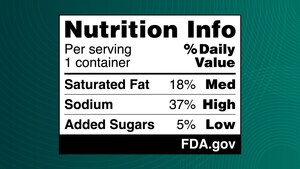SILVER SPRING, Md., Sept. 1, 2020 /PRNewswire/ -- September is National Food Safety Education Month and it's the perfect time to learn the key steps for food safety: Clean, Separate, Cook and Chill. Not sure how to include these steps when prepping and cooking at home? The U.S. Food and Drug Administration's (FDA) Food Safety in Your Kitchen materials provide food safety information to help you plan your next meal. You'll find delicious recipes (with steps for food safety already built in), fact sheets, and tips on safe meal prep, storage, and shopping. And, if you are a young adult, the Everyday Food Safety materials can help you learn the basics of food safety. The materials include a helpful video and tip sheets on each of the steps below.
Clean
- Wash your hands with warm water and soap for at least 20 seconds before and after handling food.
- Wash all produce thoroughly under running water so dirt and bacteria are not transferred from the surface when peeling or cutting produce.
- Wash your cutting boards, dishes, cooking tools, and countertops with hot soapy water after preparing each food item.
Separate
- Raw meat, poultry, seafood, eggs, and flour should not come in contact with foods that are ready to eat, such as produce. Keep them separate while shopping, storing, or cooking.
- Use a separate set of cooking tools for raw meat, poultry, seafood eggs, and flour.
- Don't reuse marinades used on raw foods unless you bring them to a boil first.
Cook
- Check the temperature with a food thermometer! Make sure food is cooked to a safe internal temperature before you eat it. Not sure what the correct temperature is? Here's a quick reminder:
- Poultry should be cooked to 165° F.
- Ground meat, meat mixtures, and egg dishes should be cooked to 160° F.
- Beef, pork, and ham should be cooked to 145° F and allowed to rest for 3 minutes.
- Fish and seafood should be cooked to 145° F.
Chill
- Refrigerate or freeze meat, poultry, eggs, seafood, and other perishables within 2 hours of purchasing or cooking (or 1 hour if kept in air temperatures above 90° F).
- Never thaw food on your countertop! For defrosting, stick to using the fridge, immersing food in cold water (change water every half hour to make sure it stays cold) or using cold running water, or thaw during cooking, such as thawing in the microwave and immediately cooking.
For more information on each of these steps, check out FDA's Everyday Food Safety videos. You'll learn more about how to safely buy, prepare, and store food. If you're looking for even more information on food safety, check out FDA's Education Resource Library and select "To Download or Order Materials." To sort by food safety materials, select "Food Safety" under "Subjects" and click "Apply." Many items are available in Spanish.
Contact: Media: 1-301-796-4540; Consumers: 1-888-SAFEFOOD (toll free)
SOURCE U.S. Food and Drug Administration
WANT YOUR COMPANY'S NEWS FEATURED ON PRNEWSWIRE.COM?
Newsrooms &
Influencers
Digital Media
Outlets
Journalists
Opted In




Share this article